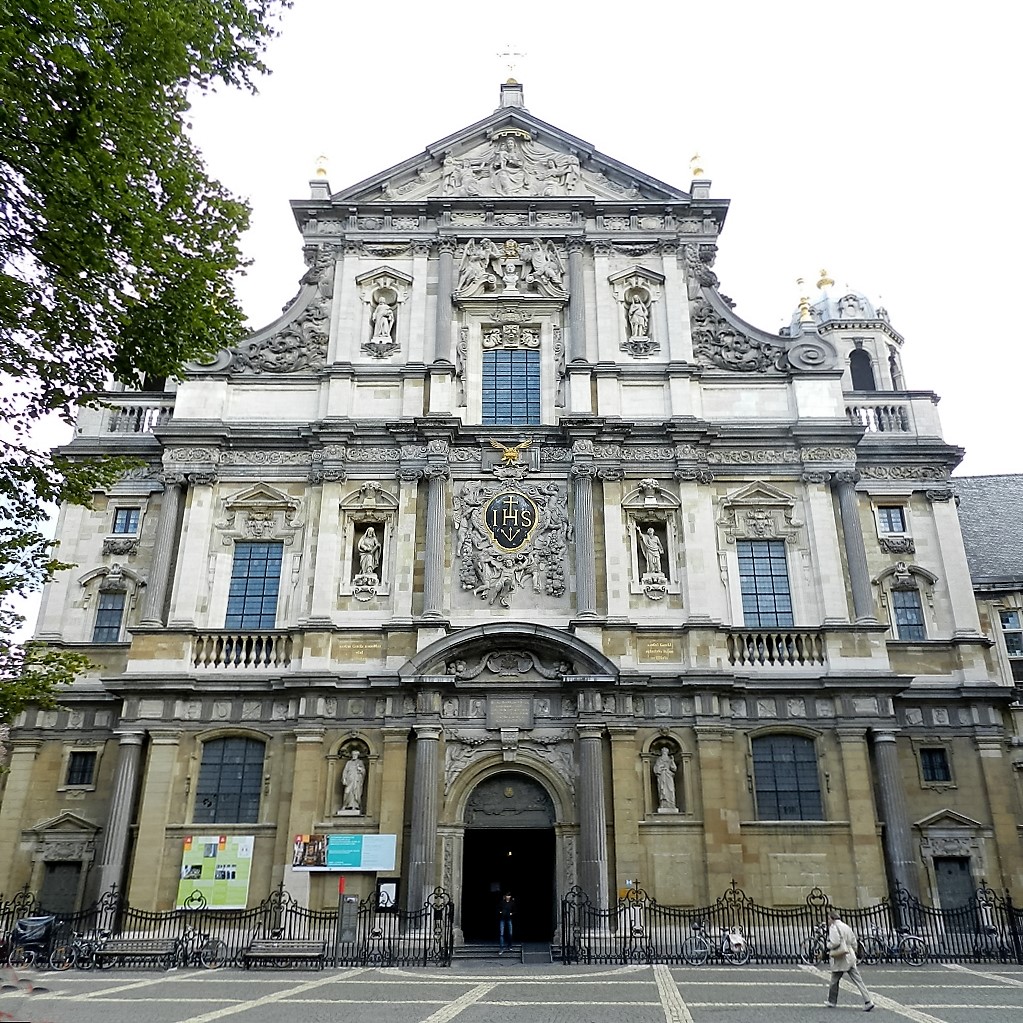The Antwerp jesuit church, a revelation.
In the sacristy cupboards
A rich lace and textiles collection
The Charles Borromeo Church lace collection completely consists of pieces that have been used in this church in the course of time, and that were produced in the Antwerp area. Most striking is the great number of pieces of linen ornamented with lacework and 17th century strips of lace. The great variety of types of lace illustrates the enormous importance of Antwerp as a centre of lace trade in the Southern Low Countries in the 17th and 18th centuries.
One of the most important pieces in the collection is the communion railA low enclosure of the choir or a chapel in the form of a long kneeling pew. Before the Second Vatican Council, it was customary to receive communion kneeling on at this pew. cloth that has been composed of fragments of a Lenten veilHeadgear worn by female religious. Until the Second Vatican Council, all nuns wore wimples, which covered the entire hair and neck. Nowadays, the veil is usually worn on the hair. that was made ca. 1621 to hide the high altarThe altar is the central piece of furniture used in the Eucharist. Originally, an altar used to be a sacrificial table. This fits in with the theological view that Jesus sacrificed himself, through his death on the cross, to redeem mankind, as symbolically depicted in the painting “The Adoration of the Lamb” by the Van Eyck brothers. In modern times the altar is often described as “the table of the Lord”. Here the altar refers to the table at which Jesus and his disciples were seated at the institution of the Eucharist during the Last Supper. Just as Jesus and his disciples did then, the priest and the faithful gather around this table with bread and wine. from view during LentThis is the period of preparation for Easter. It begins on Ash Wednesday and ends on the Saturday before Easter. Without the six Sundays of Lent, there are 40 days in which Christians are expected to live more austerely. The last week of Lent is called Holy Week.. It consists of parts of filet lace and open embroidery. The squares in filet lace represent scenes from the life of SaintThis is a title that the Church bestows on a deceased person who has lived a particularly righteous and faithful life. In the Roman Catholic and Orthodox Church, saints may be venerated (not worshipped). Several saints are also martyrs. Ignatius. The copper engravings by Cornelius I Galle from the book Vita Beati P. Ignatii Loiolae (1609) served as examples for this fancywork. Also important is to know that these engravings were made after designs by P.P. Rubens.
Besides the many strips of bobbin and needlepoint lace there is an interesting collection of 18th century communionThe consumption of consecrated bread and wine. Usually this is limited to eating the consecrated host. cloths seamed with gossamer bobbin lace.
The textile collection also contains a considerable number of antependia (altar frontals) and 17th and 18th century garments, made of precious silk fabrics, velvet and cloths of gold and silver, abundantly decorated with embroidery with gold thread and colourful silk.
A unique example of Antwerp craftsmanship is the so-called Rubens garment with a matching antependiumLiterally: “something hanging in front”. An ornament placed in front of the altar and usually covering it completely. An antependium can be made of various materials: silver (as in Antwerp cathedral), wood but also textiles. In the latter case it is sometimes adapted to the liturgical colours. from 1629, from the Carmelite church in Meir. The watered cloth of silver is decorated with ornamental vines in relief gold embroidery and figurative medallions in flat embroidery with colourful silk. The scenes were inspired by compositions by Rubens.
Exceptionally beautiful is the silk embroidery from China. A 17th century antependium shows colourful birds and trails of flowers around a majestic IHS monogram in gold embroidery. From the 18th century there are a set of garments, two antependia and a canopy decorated with little flowers, birds and butterflies embroidered with colourful silk threads onto white silk. Also as a kind Chinese featured woman on the chasubleSleeveless coloured garment worn by the priest above the alb and the stole during mass. Mary looks motherly good. Let us not forget that there was a mutual artistic influence: the missions in the Far East were first provided with religious works of art and especially with thousands of engraved prints from Antwerp.

- Saint Charles Borromeo’s Church
- History & Description
- Introduction
- The historic context
- Square and residence
- Previous history
- The college
- Spatial effects
- Names of streets
- Profess house
- Sodality building
- Façade
- Tower
- Interior
- High altar
- Pulpit
- Confessionals
- Ceiling paintings
- Our Lady’s chapel
- Saint Ignatius chapel
- Chapel of Saint Francis Xavier
- Galleries
- Organ
- Sacristy
- When leaving
- Epilogue
- Bibliography

